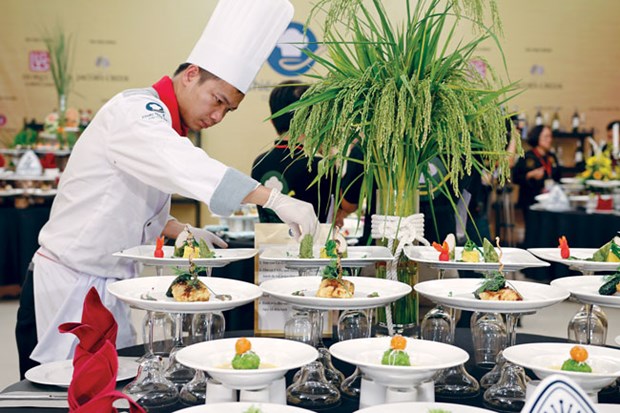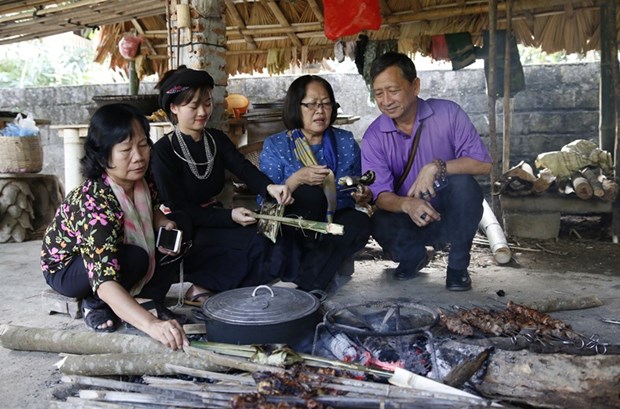That’s what Mr. Chiem Thanh Long – Food expert and professional judge of The Golden Spoon contest – said at the launch of the Center for Research, Conservation and Development of Vietnamese Cuisine (CRDC).
Launched
in early April at the same time with Vietnam International Travel Fair - VITM
Hanoi 2017, CRDC’s main tasks are about distilling, preserving and promoting
the most precious essence in both food and drinks of the homeland while
eliminating Vietnamese cuisine up to the world market. On this occasion, the
Urban newspaper had a talk with Chiem Thanh Long, deputy director in charge of
CRDC’s objectives and activities.

Mr. Chiem Thanh Long
May
you tell us the mission and activity structure of CRCD?
Its
name already represents itself: researching, conservation, and developing
Vietnamese cuisine. Ideas and intention about this center were born in 2016 but
there were still some difficulties so it had not been launched.
We
chose the occasion of VITM 2017 in Ha Noi to introduce CRDC because the event
itself was attractive. Visitors and national firms/organization from domestic
and international would be there so the center should be known by more people.
The
center is directly under management of HCMC Tourism Association, basing on
delegation of Vietnamese Tourism Association (VTA). We located the center in
HCMC because of our human resource.
This
is the first time that Vietnam has a specified center of researching,
conservation, and developing Vietnamese cuisine. Definitely the amount of work
is not small. Are there any problems in organizing and building staff?
We
have planned in details for each stage. First is to exploit abilities of
participating experts while to expand staff network through CRDC website. We do
have extreme advantage of existing local and regional food experts/chefs so
CRDC would be a head quarter where all information comes into. This is a very
connective network with lots of supports from all over the country. Although
the amount of work is huge, it has been equally divined so really it should not
be a problem.
Recently,
following the point of VTA, we will begin to link local associations from
provinces and cities. We will hold a club or a group of local chefs in each
province. Besides that, another advantage is a really qualified network of
chefs and food experts that we have had through The Golden Spoon Awards. This
is a high-credit contest, where almost all professional chefs and experts in
all over Vietnam have gathered.

Through The Golden Spoon – professional cooking contest, CRDC can weave a supreme network of professional staff. Photo: Trung Dung
During
preparation time, particular departments of CRDC have been working on some
local specialties, such as fresh ginger in Dong Nai, and next topic will be
coconut in Ben Tre. Preserving department also started skimming popular
Vietnamese spices.
What
are the priorities of the center in this beginning? Which activities will be
promoted?
We
have 3 main departments, which are researching, conservation, and developing.
But if we straightly follow this order, it will take lots of time and people
may not see the results of their hard work. Therefore, all tasks are parallel
updated and completed. If a dish is confirmed to be on conservation, there will
be a plan of introducing and developing the dish to make it popular. Generally,
we separate by geography and professional tasks but we all support each other.
There is always “soft borders” in our working environment.
Of
course, depending on the subjects (food, beverages, or spices), we will have
spike plan for each item. We just finished an exam at Ha Giang province. It has
plenty of precious spices but somehow those are not popular. In near future,
CRDC will put effort on researching and introducing those special spices of
Vietnam.
Where
is the fund for this center’s activities, sir?
CRDC
is a non-profit organization and its purpose is to collect, preserve and
promote the unique features and potential of Vietnamese cuisine. Fund is a
dilemma. Therefore, in the beginning, besides the professional work, CRDC is
also conducting food business at 18 Truong Dinh (Ward 6, District 3, HCMC).
This is only an initial step to generate some revenue. When the center has
grown up, I think, this is also an effective channel for localities to
introduce and promote the products of our homeland.
For
further future, we hope to find financial supporters and donors from relative
fields of cuisine. Besides, one of the main activities of the center is to
support localities and to seek for new fund, such as holding culinary events,
holding cooking skill contests, or teaching Vietnamese food for foreign
tourists.
For
now, our experts just stand by each other because of their, and our passion
with Vietnamese cuisine (smile).
Seems
like too many targets. Are you afraid of overwhelming during working process?
I
am not!
When
CRDC was born, it’s really close to a culinary guaranty with me. The voice of a
food expert about a dish is always an individual opinion but if a dish was
discovered by CRDC, it has to pass the whole process of studying, researching
(recipes, nutrition facts, or usages) from our chefs, food experts,
nutritionist, and even our doctors. The dish must also earn certificates from
national specialized organizations. Therefore, once it is on air, even the
pickiest diner should trust and try it.
From
that basic idea, the center will identify and recognize the best and the most
typical dishes from all Vietnamese restaurant, which is alike Michelin stars
that other countries have been doing. This work is absolutely no charge, totally
objective, and of course there are many parties will get involved in testing,
supervising, and evaluating.
In
near future, we are going to plan a food festival named Vietnamese Culinary
Elite. I hope this is a high kick to prove how CRDC can create effects and
influences for Vietnamese cuisine, in general, and for localities in specific.

CRDC experts went on a trip of discovering Tay minority’s cuisine at Ha Giang. From the left: Mr. Chiem Thanh Long, Food artist Bui Thi Suong, a Tay girl, and nutritionist Bui Thi Minh Thuy. Photo: Trung Dung
So
how does the marketing plan work? To attract more tourist coming in or to bring
Vietnamese food and Vietnamese restaurant abroad?
Actually,
exporting Vietnamese cuisine to other countries is extremely hard because of
gaps between two different cultures, diplomatic, and economical condition. For
examples, if you want to bring food abroad, food must go along with diplomatic
delegation or exchanging programs. However, those occasions require fewer
dishes with simple recipes for convenience. The most popular choices are phở, chả giò (fried spring rolls), and gỏi cuốn (fresh spring rolls) because
sometimes those kinds of festival do not allow cooking on fire. But later, if
we have branded Vietnamese restaurants in other countries, it will so much
easier for introducing, promoting, and tech transference.
What
is the most difficult task of culinary research?
The
hardest part is to define the origin of a dish. For example, bánh xèo (crispy pancakes) is
everywhere, from the South to the Central. But in Hue city, it is called bánh khoái. We have to base on geography
aspect to trace back its origin. This recent time is still good for collecting
and comparative study because no one knows how the original food will change
after a couple decades, when all old people pass away. Moreover, heirloom
dishes will never be revealed their accurate recipes.
Indeed,
I think it would be great if we have a museum of Vietnamese cuisine!
A
part in CRDC’s orientation is to educate and to train cooking career. How is it
in detail?
It
depends on the fund and the interests of localities. If a province wants to
develop cooking career, they will ask for our support. Occasionally, CRDC also
holds professional seminars to improve cooking skills for working chefs with
top experts.
CRDC
will also hold frequent programs, where cooking groups/clubs can introduce
their own food and typically local dishes, such as Vietnamese Culinary Elite
program with our motto “be diverse but don’t be repetitive”. Besides
introducing regional food and promoting local cuisine, CRDC also guides,
presents modern cooking and mixing techniques as molecule gastronomy.
The
Vietnam Culinary Conservation, Research and Development Center (CRDC) was
established in accordance with Decision 62 / QD-HHDLVN of the Vietnam Tourism
Association. The Center consists of a Culinary Advisory Board and four
professional boards. CRDC will set up and organize a number of research topics
on specific Vietnamese dishes and beverages, as well as identify specific and
long-term directions for activities in each area such as exploration, research
Nutrition of each typical food/drink of Vietnam with the motto "delicious
and healthy"; calibrating dishes for national events; selecting cuisine to
promote and to attract more tourists by specific segments. In August 2017, the
official website of CRDC in both English and Vietnamese version will be on air
to provide comprehensive information on Vietnamese cuisine for ordinaries and
visitors.
Writer: Nguyen
Trang
Translator: Thu
Pham